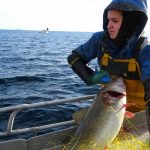According to the U.S. Commerce Department a new plan to cap the number of king salmon caught each year by the Bering Sea pollock fleet has been approved. The new plan is said to minimize the trawlers from wasting chinook, or king, salmon that would otherwise return to the Yukon River and other spawning grounds.
Western Alaska leaders who had pushed for much tighter restrictions blasted Commerce Secretary Gary Locke’s decision to accept the plan, which was recommended last year by the North Pacific Fishery Management Council. Myron Naneng, president of the Bethel-based Association of Village Council Presidents, said that Western Alaskan tribes as well as those responsible for managing our fisheries in river spoke loudly and clearly, but our requests fell on deaf ears to both the council and the Secretary of Commerce.
On the contrary the government officials said that the new program will change the way the pollock fleet operates in the Bering Sea — and that the fishery council’s focus on king salmon bycatch is already paying off with a sharp reduction in the number of the species the trawlers catch.
Doug Mecum, deputy regional administrator for NOAA Fisheries in Alaska., expressed that people are generally recognizing that the fleet has already changed its fishing practices. Mecum also said that fewer than 20,000 kings a year have been caught by the pollock fleet over the past three years.
In April 2009, the fishery council recommended the Commerce Department limit the pollock fleet’s catch to fewer than 47,951 king salmon a year — or up to 60,000 in any two out of seven years if the fleet participates in an incentive plan. Groups such as the Association of Village Council Presidents, which represents dozens of Yukon-Kuskokwim villages, called for a bycatch cap of 30,000 king salmon.








